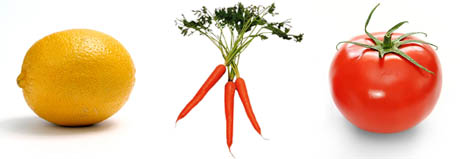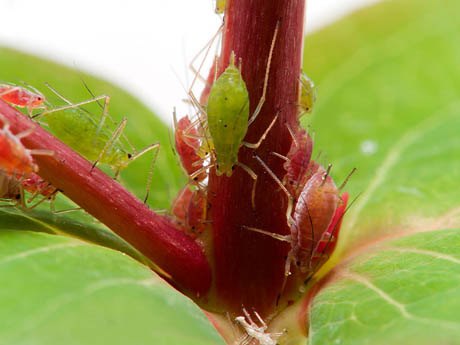
IMAGE: Red, yellow-green, and green pea aphids. Photo courtesy of Charles Hedgcock, R.B.P., via NPR.
Over at the Agricultural Biodiversity Weblog, an Edible Geography favourite, Jeremy links to a fascinating post about transgenic pea aphids. The pea aphid has been the focus of quite a bit of biological excitement lately as the findings of the Aphid Genome Project are gradually released: the tiny insects can change their shape in response to food supply and environmental conditions, with the option to become wingless, winged, sexual, asexual, or “morphs that are specialized to resist desiccation or to defend the colony.”
The latest and greatest aphid super power was discovered by researcher Nancy Moran, who wanted to understand exactly how pea aphids can change colour, from green to red via a sickly yellow. Scientists already knew that the red colour came from carotenoids, a class of organic pigments that includes such micro-nutrients as lutein, lycopene, and beta-carotene, and that is responsible for the yellowness of lemons, the orangeness of carrots, and the redness of tomatoes.

As computational biologist Iddo Freidberg points out at Byte Size Biology, carotenoids are also responsible for the pinkness of flamingos and salmon, as well as the orange glow prized by sunless tanners. To achieve such colouration, animals and humans must eat foods that contain the pigment, since it is a well-known fact, according to Moran, that “animals do not make carotenoids.”

IMAGE: Flamingo via by Flickr user Art Goeren; salmon; and an orange-toned Chelsy Davy.
Or at least, that was the accepted wisdom until Nancy Moran decided to look for carotenoid-synthesising genes in her aphid DNA. To her amazement, she found them, which makes pea aphids the only animals on earth known to be able to produce their own carotenoids.
Further detective work showed that rather than eat carotenoid-rich foods or host an in-house carotenoid-factory run by symbiotic bacteria, ancestral pea aphids actually went the whole hog and stole an entire sequence of DNA coded to synthesise carotenoids from some pathogenic fungi, spliced it into their own genome, and passed their new carotenoid-producing super power down the generations. The process is called lateral gene transfer, and according to Moran, “although gene transfers between microorganisms are common, finding a functional fungus gene as part of an animal’s DNA is a first.”

IMAGE: Red and green pea aphids. Photo courtesy of Charles Hedgcock, R.B.P., via NPR.
Pea aphids use their carotenoids to spread risk: apparently “red aphids are more susceptible to parasitic wasps, whereas green aphids are more susceptible to predators such as lady-bird beetles.” Humans, on the other hand, require carotenoids for health: deficiencies of Vitamin A and other carotenoids can cause blindness and a weakened immune system.
To that end, researchers have spent a considerable amount of time and energy splicing carotenoid-synthesising genes (in this case, from a daffodil and a bacterium called Erwinia uredovora, which causes soft rot diseases in fruit) into a staple food, such as rice, to create biofortified transgenic foods designed to reduce deficiency-related diseases in developing countries. Interestingly, the kind of highly controversial lateral gene transfer that creates Golden Rice™ (or, for that matter, Monsanto’s Roundup Ready soybeans) is an artificial analogue of the process pea aphid forefathers undertook when they lifted a genetic sequence from fungi and incorporated it into their own DNA.

IMAGE: Normal rice (left) compared to Golden Rice™ (right), via.
But what if we cut out the middle man, followed in the pea aphids’ footprints, and spliced some carotenoid-synthesising genes into our own DNA? The thought has clearly occurred to Nancy Moran. As she told Science Daily,
Animals have a lot of requirements that reflect ancestral gene loss. This is why we require so many amino acids and vitamins in the diet. Until now it has been thought that there is simply no way to regain these lost capabilities. But this case in aphids shows that it is indeed possible to acquire the capacity to make needed compounds.
The implications are quite breath-taking: perhaps, then, we could deliberately engineer a new race of biofortified transgenic humanoids capable of self-synthesising their own micro-nutritional requirements.
Doubtless, this would result in the same sorts of unintended, surreal, and occasionally disastrous consequences that these kinds of ambitious human interventions into complex systems always seem to cause, but maybe it’s more appropriate to experiment on ourselves directly, rather than on the plants we and other animals consume?
In any case, the scenario makes a wonderful thought-experiment: trying to imagine the consequences of this transgenic future makes the centrality of food production, preparation, and consumption to every aspect of human existence dramatically clear.